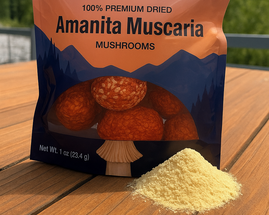Posted by Wild Forest Herbs on Aug 24th 2025
Amanita Muscaria Potency Over Time: New Testing from Wild Forest Herbs Challenges Common Beliefs
A common question Wild Forest Herbs hears about Amanita muscaria mushrooms is: how much do dried Amanita muscaria lose potency over time?
This is an important question. Because Amanita muscaria only grow in the wild and cannot be cultivated indoors, they can only be harvested in summer when the mushrooms fruit. This means the summer harvest needs to last till the following summer. So we wanted to understand if there was a large difference in potency between the dried mushrooms we sold soon after the harvest versus the mushrooms we sold 7 months later. We also wanted to understand what happens when customers store mushrooms at home--do dried Amanita muscaria lose potency without special storage techniques?
Our groundbreaking lab test
Most sources on the internet hypothesize that dried Amanitas degrade over time—perhaps because this is true for psilocybin mushrooms. But when we put that belief to the test for Amanita muscaria, the results told a different story.
At Wild Forest Herbs, we decided to run a test using a methodology designed to eliminate one of the biggest challenges in mushroom testing: natural variability. Not only can two Amanita muscaria mushrooms differ in potency, but even different parts of the same mushroom can carry uneven levels of active compounds.
To solve that problem, we finely blended dried Amanita muscaria into a uniform powder, ensuring consistency. That powder was tested twice by ACS Laboratory, an independent and nationally trusted testing service. The two tests from the same powder sample were over 7 months apart. The second test was run in mid-July to test the potency of the oldest possible dried mushrooms before a fresh harvest is gathered in the summer. The testing dates were:
- December 12, 2024
- July 18, 2025 (over seven months later)
Surprising results on Amanita muscaria shelf life
The results surprised us.
- Ibotenic Acid: rose from 7.186 mg/g to 7.81 mg/g
- Muscimol: rose from 0.641 mg/g to 0.697 mg/g
Now, we don’t believe the mushrooms actually became stronger sitting on the shelf. The slight increases in potency are almost certainly due to a small variation in the blended powder or the natural margin of error within lab testing. But the key takeaway is clear: the potency did not decline.
This test only covers a 7-month period, so it’s still possible that potency may decline over longer storage times. But these initial results run directly counter to the common assumption that dried Amanitas lose potency over time.
Amanita muscaria remained stable under tough conditions
To simulate what a customer might experience, we deliberately made the testing conditions difficult. We tested powder, which would be expected to lose potency faster than whole mushroom caps. This is because when the mushroom is blended into a powder, the integrity of the mushroom is lost and all particles of the mushroom are directly exposed to air and moisture. This makes those particles more vulnerable to oxidation, hydrolysis, and other chemical breakdown processes.
Additionally, we did not use any fancy storage techniques. The sample was:
- Stored in our high quality airtight product pouches—no added desiccants, antioxidants, or preservatives.
- Stored at normal room temperature—not frozen or refrigerated.
- Kept in a dark place to avoid direct exposure to light (we simply put the sample in a paper bag on a shelf).
Our test results show that as long as Amanita muscaria are stored with basic care (away from the light and in quality airtight packaging like our Wild Forest Herbs pouches), their potency should hold up well—contrary to popular opinion.
Amanita muscaria appears much more stable than psilocybin mushrooms
What might explain these results? While dried psilocybin mushrooms have been shown to lose potency over time, their main psychoactive compounds are psilocybin and psilocin—which are relatively unstable (especially psilocin). By contrast, the main psychoactive ingredients in Amanita muscaria are muscimol and ibotenic acid, completely different compounds that appear to have much better stability—at least according to our test results.
At Wild Forest Herbs, we’re proud to contribute real data to the body of knowledge around Amanita mushrooms. We’ll continue to explore and share what we learn, but for now, this test adds a new data point to the growing understanding of Amanita muscaria’s unique properties.
DRIED AMANITA MUSCARIA, POTENCY TEST RESULT: JULY 18, 2025

DRIED AMANITA MUSCARIA, POTENCY TEST RESULTS: DECEMBER 12, 2024


